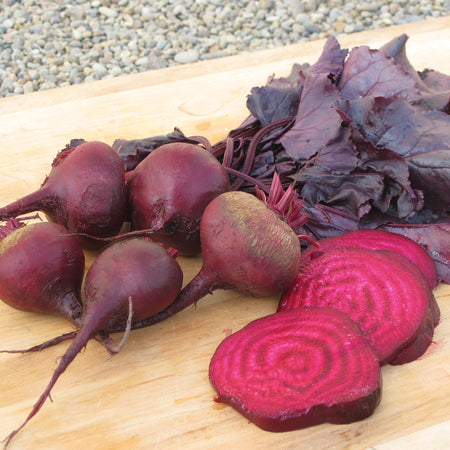64 days. The renaissance of the salad mix has made unique uses for all types of greens, and the leaves of Bull’s Blood are a regal addition. The strong, deep red tops grow to 13 inches tall and have a clean crisp flavor. The 3–4 inch round roots have delightful red and white zoning. Harvest when small for the very best in eating quality.
Beta vulgaris This wholesome vegetable is doubly heart-healthy. The sweet, delicious roots contain high levels of glycine betaine. This phytochemical compound fights platelet clots and plaque formation in the arteries. Along with a wealth of potassium, calcium and vitamin A, hearty beet greens are rich in fiber, which may reduce the risk of coronary heart disease.
Days to maturity are calculated from date of direct seeding.
Culture
• Beets perform best in fertile, evenly moist soil with a pH of 6.0-7.0
• Uniform soil moisture is essential
• Sudden changes in temperature or soil moisture will increase zoning (ring formation in the root) and lead to premature bolting
• Transplanting not recommended as it can damage the tap root
Direct Sowing
• At the bottom of the furrow band 1 cup of TSC's Complete fertilizer per 10 row feet
• Cover seeds with sifted compost, loose soil, or vermiculite and water evenly
• Use row cover when soil temperatures are cool and to protect from pests
• Sow June—August for a fall crop
Insects & Diseases
• Common insects: Leaf miners, flea beetles, and leaf hoppers
• Insect control: Pick off affected leaves and check for eggs—if found, spray with Pyrethrin
• Common diseases: Scab
• Disease prevention: Neutral pH (7.0), 3-4 year crop rotation, keep adequately watered
• Common pests: Mice, voles, and gophers
• Pest control: Traps or underground screens
Harvest & Storage
• Harvest when roots reach desired size; small roots are tender, large roots may become woody if left in the ground too long
• Leaves can be used as pot greens or in salads
• Trim tops and store at 36°F and 95% relative humidity
Fall & Winter Harvest
• Beets should be harvested before temperatures drop to the 15-20°F range
• If you are in a temperate climate, and your soil is well drained, your best location for root storage is in the garden under a protective layer of straw
KEY TO BEET DISEASE RESISTANCE AND TOLERANCE
HR indicates high resistance.
IR indicates intermediate resistance.
BLS | Bacterial Leaf Spot
C | Cercospora
What is seed tape?
Seed tapes are perfectly straight rows of precisely spaced crops. No more having to thin seedlings! This biodegradable tape will plant a row 5 meters (16 feet, 5 inches) long. Simply lay it in a furrow and cover with a light layer of sifted compost or soil, water and wait. Save yourself a heap of planting time with these popular vegetable and herb staples.
Beta vulgaris This wholesome vegetable is doubly heart-healthy. The sweet, delicious roots contain high levels of glycine betaine. This phytochemical compound fights platelet clots and plaque formation in the arteries. Along with a wealth of potassium, calcium and vitamin A, hearty beet greens are rich in fiber, which may reduce the risk of coronary heart disease.
Days to maturity are calculated from date of direct seeding.
Culture
• Beets perform best in fertile, evenly moist soil with a pH of 6.0-7.0
• Uniform soil moisture is essential
• Sudden changes in temperature or soil moisture will increase zoning (ring formation in the root) and lead to premature bolting
• Transplanting not recommended as it can damage the tap root
Direct Sowing
• At the bottom of the furrow band 1 cup of TSC's Complete fertilizer per 10 row feet
• Cover seeds with sifted compost, loose soil, or vermiculite and water evenly
• Use row cover when soil temperatures are cool and to protect from pests
• Sow June—August for a fall crop
Insects & Diseases
• Common insects: Leaf miners, flea beetles, and leaf hoppers
• Insect control: Pick off affected leaves and check for eggs—if found, spray with Pyrethrin
• Common diseases: Scab
• Disease prevention: Neutral pH (7.0), 3-4 year crop rotation, keep adequately watered
• Common pests: Mice, voles, and gophers
• Pest control: Traps or underground screens
Harvest & Storage
• Harvest when roots reach desired size; small roots are tender, large roots may become woody if left in the ground too long
• Leaves can be used as pot greens or in salads
• Trim tops and store at 36°F and 95% relative humidity
Fall & Winter Harvest
• Beets should be harvested before temperatures drop to the 15-20°F range
• If you are in a temperate climate, and your soil is well drained, your best location for root storage is in the garden under a protective layer of straw
KEY TO BEET DISEASE RESISTANCE AND TOLERANCE
HR indicates high resistance.
IR indicates intermediate resistance.
BLS | Bacterial Leaf Spot
C | Cercospora
What is seed tape?
Seed tapes are perfectly straight rows of precisely spaced crops. No more having to thin seedlings! This biodegradable tape will plant a row 5 meters (16 feet, 5 inches) long. Simply lay it in a furrow and cover with a light layer of sifted compost or soil, water and wait. Save yourself a heap of planting time with these popular vegetable and herb staples.
